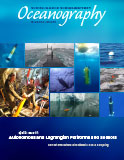First Paragraph
We describe the development of a small profiling float, the ALAMO (Air-Launched Autonomous Micro-Observer), that observes upper-ocean structure over a year. These floats can be launched from any aircraft equipped with an “A-sized” launch tube, or from the door of any other aircraft. Profiling floats have found wide use in the oceanographic community, from their original design in the World Ocean Circulation Experiment (Davis et al., 1992) to their current widespread usage in the Argo program (Riser et al., 2016). The utility of profiling floats derives from their relative affordability and their autonomous nature once deployed. The ALAMO float works on the same principles as the ALACE (Autonomous Lagrangian Circulation Explorer) profiling float designed by Davis et al. (1992), which developed into the SOLO (Sounding Oceanographic Lagrangian Observer) profiling floats used in the Argo program today (Davis et al., 2001). The ALAMO float represents a natural progression of those earlier designs.

